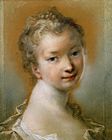Rosalba Carriera
Rosalba Carriera | |
|---|---|
 Self-portrait, 1715 | |
| Born | 12 January 1673 Venice |
| Died | 15 April 1757 (aged 84) Venice |
| Nationality | Venetian |
| Known for | Portrait painting |
| Movement | Rococo |
Rosalba Zuanna Carriera (12 January 1673[1][2] – 15 April 1757) was a Venetian Rococo painter. In her younger years, she specialized in portrait miniatures. She later became known for her pastel work, a medium appealing to Rococo styles for its soft edges and flattering surfaces.
Biography
Born in Venice with two sisters, Rosalba Carriera was a prominent and greatly admired portrait artist of the Italian Rococo. Her family was from the lower-middle-class in Venice, and as a child, she began her artistic career by making lace-patterns for her mother, who was engaged in that trade. By 1700 she was already creating miniatures and by 1703 she completed her first pastel portraits.[3] Others claim that she received initial instruction in oil technique from the Venetian painter Giuseppe Diamantini.[4]

As snuff-taking became popular, Carriera began painting miniatures for the lids of snuff-boxes, and was the first painter to use ivory for this purpose. Gradually, this work evolved into portrait-painting, for which she pioneered the exclusive use of pastel. Prominent foreign visitors to Venice, young sons of the nobility on the grand tour and diplomats for example, clamored to be painted by her.[5] The portraits of her early period include those of Maximilian II of Bavaria; Frederick IV of Denmark; the 12 most beautiful Venetian court ladies; the "Artist and her Sister Naneta" (Uffizi); and August the Strong of Saxony, who acquired a large collection of her pastels.[6]
By 1721, during Carriera's first trip to Paris, portraits by her were in great demand. While in Paris, as a guest of the great amateur and art collector, Pierre Crozat. She painted Watteau, all the royalty and nobility from the King and Regent downwards, and was elected a member of the Academy by acclamation.[7] Her brother-in-law, the painter Antonio Pellegrini, married to her sister Angela, was also in Paris that year. Pellegrini was employed by John Law, a British financier and adventurer, to paint the ceiling of the Grand Salle in Law's new Bank building.
Carriera's other sister, Giovanna, and her mother, were members of the party in France. Both sisters, particularly Giovanna, helped her in painting the hundreds of portraits she was asked to execute. Carriera's diary of these 18 months in Paris was later published by her devoted admirer, Antonio Zanetti, the Abbé Vianelli, in 1793. Her extensive correspondence has also been published.[8] She returned to Venice in 1721, visited Modena, Parma, and Vienna, and was received with much enthusiasm by rulers and courts.
In later life, Carriera made a long journey to the court of the Poland. The works she executed there were later to form the basis of the large collection in the Altemeister Gallery in Dresden. In 1705, she was made an 'Accademico di merito' by the Roman Accademia di San Luca, a title reserved for non-Roman painters.
Still immensely popular and in great demand (and, in effect, the wage-earner of her family), Carriera returned to Venice. Her portraits were highly refined and flattering, almost always consisting of a bust-length pose, with the body turned slightly away and the head turned to face the viewer. Carriera had an unusual ability to represent textures and patterns, faithfully re-creating fabrics, gold braid, lace, furs, jewels, hair and skin and show-casing the sumptuous, material life-style of her rich and influential patrons. Her self-portrait work diverges from typical expectations of women artists of the time by aiming for an unvarnished appearance. One such example is Self-Portrait as an Old Woman (c.1746), whose mismatched eyes hint at the eye problems which plagued her in later life.[9]
The last years of Carriera's long life were tragic, as her sight, which might have been damaged by miniature-painting in her youth, deserted her completely, and she went blind. She endured two unsuccessful cataract operations. She outlived all her family, spending her last years in a little house in the Dorsoduro district of Venice, where she died at the age of 84.
Legacy
In Prideaux Place, Padstow, Cornwall, there is a charming portrait by Carriera of Humphrey Prideaux, the archetypal gentry son pictured on his "Grand Tour," in which a love-letter from Carriera to the sitter is reputed to have been hidden behind the frame. She had many male friends and many aristocratic admirers of her talent.
Gallery
-
Self-portrait -
Self-portrait -
Self-Portrait -
Self Portrait as Winter -
Young Girl -
Caterina Sagredo Barbarigo -
Felicita Sartori in Turkish costume -
Young Girl Holding a Monkey -
Woman with Flowers -
Flora (1730) -
Spring -
Four Seasons -
French Consul Le Blond -
Young Cavalier -
Gentleman in Red -
Cardinal Melchior de Polignac
References
- ^ Jeffares, Neil. "Dictionary of Pastellists before 1800" (PDF). pastellists.com.
- ^ "Rosalba Carriera". finestresullarte.info.
- ^ Heller, Nancy G. (2003). Women Artists. New York: Abeville Press. p. 55.
- ^ Hobbes, James R. (1849). Picture collector's manual adapted to the professional man, and the amateur. T&W Boone, 29 Bond Street. p. 74.
- ^ Rosalba Carriera by Bernardina Sani, Umberto Allemandi & co. Ed. (1988), as reviewed by Francis Russell, The Burlington Magazine (1989) p857
- ^ New International Encyclopedia
- ^ New International Encyclopedia
- ^ Rosalba Carriera: lettere, diari, frammenti by Bernardina Sani, Leo S. Olschski ed., Firenze (1985), as reviewed by Francis Haskell in The Burlington Magazine 1987. p122-123
- ^ Frances Borzello, Seeing Ourselves: Women's Self-Portraiture 1998
Sources of information
- Consult the biographies of Sensier, with translation of her diary (Paris. 1865), Von Hoerschelmann (Leipzig, 1908), and Malamani (Milan, 1910).
- Elsa Honig Fine puts Rosalba Carriera in context with other women artists in Women and Art: A History of Women Painters and Sculptors from the Renaissance to the 20th Century (London & Montclair, 1978).
- Sensier's (highly annotated) version of her journal of two years in Paris (1720-1721) is available on-line in French:
External links
- Neil Jeffares, Dictionary of pastellists before 1800, online edition
- Anna Kleinman Research Files on Rosalba Carriera, English translations of the correspondence and diary of Rosalba Carriera in The Frick Collection/Frick Art Reference Library Archives.
- 1675 births
- 1757 deaths
- People from Venice
- People from Chioggia
- Venetian painters
- Portrait miniaturists
- Italian portrait painters
- 17th-century Italian painters
- 18th-century Italian painters
- 18th-century Italian women
- Italian women painters
- Blind artists
- Pastel artists
- People with cataracts
- 18th-century women artists
- 17th-century women artists
- 17th-century Venetian people
- 18th-century Venetian people





















